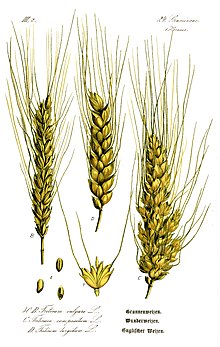Our website is made possible by displaying online advertisements to our visitors.
Please consider supporting us by disabling your ad blocker.
Triticum aestivum
| Trigo harinero | ||
|---|---|---|
 Cultivo maduro | ||
| Taxonomía | ||
| Reino: | Plantae | |
| División: | Magnoliophyta | |
| Clase: | Liliopsida | |
| Orden: | Poales | |
| Subfamilia: | Pooideae | |
| Tribu: | Triticeae | |
| Género: | Triticum | |
| Especie: |
Triticum aestivum L., 1753 | |
El trigo harinero, trigo del pan o trigo blando (Triticum aestivum o T. vulgare, donde aestivum significa veraniego), un cereal del género Triticum, es la especie de trigo más extensamente cultivada en el mundo (90-95 % del total de la producción).[1] Es una planta alohexaploide, debido a su conformación de 42 cromosomas repartidos en 6 juegos desde tres diferentes especies (Triticum spelta, Aegilops cylindrica, de 7 cromosomas cada uno).[2][3] La planta posee tres genomas idénticos, los cuales poseen información genética repetida, lo cual le confiere a la especie en sí gran adaptabilidad a los diferentes ambientes.[4][5][6][7][8] Cerca del 95 % del trigo producido mundialmente es de esta especie;[2]



Esta especie es más cultivada en las latitudes altas de ambos hemisferios. Es ampliamente empleada para obtener harina destinada a la elaboración de pan.
- ↑ Organización de las Naciones Unidas para la Alimentación y la Agricultura (FAO). «Wheat for bread and other foods». Consultado el 8 de junio de 2017.
- ↑ a b Mayer, K. F. X. (2014). «A chromosome-based draft sequence of the hexaploid bread wheat (Triticum aestivum) genome». Science 345 (6194): 1251788. PMID 25035500. S2CID 206555738. doi:10.1126/science.1251788. Archivado desde el original el 18 de marzo de 2022. Consultado el 6 de abril de 2021.
- ↑ Marcussen, T. (2014). «Ancient hybridizations among the ancestral genomes of bread wheat». Science 345 (6194): 1250092. PMID 25035499. S2CID 206554636. doi:10.1126/science.1250092.
- ↑ Brenchley, R; Spannagl, M.; Pfeifer, M.; Barker, G. L.; d'Amore, R.; Allen, A. M.; McKenzie, N.; Kramer, M.; Kerhornou, A.; Bolser, D.; Kay, S.; Waite, D.; Trick, M.; Bancroft, I.; Gu, Y.; Huo, N.; Luo, M. C.; Sehgal, S.; Gill, B.; Kianian, S.; Anderson, O.; Kersey, P.; Dvorak, J.; McCombie, W. R.; Hall, A.; Mayer, K. F.; Edwards, K. J.; Bevan, M. W.; Hall, N. (2012). «Analysis of the bread wheat genome using whole-genome shotgun sequencing». Nature 491 (7426): 705-10. Bibcode:2012Natur.491..705B. PMC 3510651. PMID 23192148. doi:10.1038/nature11650.
- ↑ Bonjean, Alain P. and William J. Angus (eds) (2001). The world wheat book : a history of wheat breeding. Andover: Intercept. p. 1131. ISBN 978-1-898298-72-4. Excellent resource for 20th century plant breeding.
- ↑ Caligari, P.D.S. and P.E. Brandham (eds) (2001). Wheat taxonomy : the legacy of John Percival. London: Linnean Society, Linnean Special Issue 3. p. 190.
- ↑ Heyne, E.G. (ed.) (1987). Wheat and wheat improvement. Madison, Wis.: American Society of Agronomy. p. 765. ISBN 978-0-89118-091-3.
- ↑ Zohary, Daniel and Maria Hopf (2000). Domestication of Old World plants: the origin and spread of cultivated plants in West Asia. Oxford: Oxford University Press. p. 316. ISBN 978-0-19-850356-9. Standard reference for evolution and early history.
Previous Page Next Page


